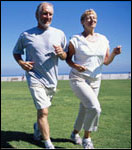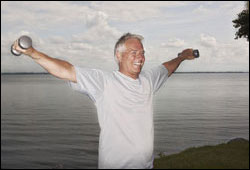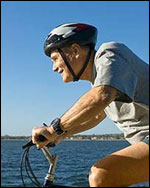How much Physical Activity do Older Adults need?
Physical Activity is Essential to Healthy Aging Adults
 As an older adult, regular physical activity is one of the most important things you can do for your health. It can prevent many of the health problems that seem to come with age. It also helps your muscles grow stronger so you can keep doing your day-to-day activities without becoming dependent on others.
As an older adult, regular physical activity is one of the most important things you can do for your health. It can prevent many of the health problems that seem to come with age. It also helps your muscles grow stronger so you can keep doing your day-to-day activities without becoming dependent on others.
Not doing any physical activity can be bad for you, no matter your age or health condition. Keep in mind, some physical activity is better than none at all. Your health benefits will also increase with the more physical activity that you do.
If you're 65 years of age or older, are generally fit, and have no limiting health conditions you can follow the guidelines listed below.
For Important Health Benefits |
||||||||||||
|---|---|---|---|---|---|---|---|---|---|---|---|---|
Older adults need at least:
|
10 minutes at a time is fine
We know 150 minutes each week sounds like a lot of time, but it's not. That's 2 hours and 30 minutes, about the same amount of time you might spend watching a movie. The good news is that you can spread your activity out during the week, so you don't have to do it all at once. You can even break it up into smaller chunks of time during the day. It's about what works best for you, as long as you're doing physical activity at a moderate or vigorous effort for at least 10 minutes at a time.
For Even Greater Health Benefits - Older adults should increase their activity to: |
||||||||||||
|---|---|---|---|---|---|---|---|---|---|---|---|---|
|
Aerobic activity – what counts?
Aerobic activity or "cardio" gets you breathing harder and your heart beating faster. From pushing a lawn mower, to taking a dance class, to biking to the store – all types of activities count. As long as you're doing them at a moderate or vigorous intensity for at least 10 minutes at a time. Even something as simple as walking is a great way to get the aerobic activity you need, as long as it's at a moderately intense pace.
Intensity is how hard your body is working during aerobic activity.
How do you know if you're doing moderate or vigorous aerobic activity?
On a 10-point scale, where sitting is 0 and working as hard as you can is 10, moderate-intensity aerobic activity is a 5 or 6. It will make you breathe harder and your heart beat faster. You'll also notice that you'll be able to talk, but not sing the words to your favorite song.
Vigorous-intensity activity is a 7 or 8 on this scale. Your heart rate will increase quite a bit and you'll be breathing hard enough so that you won't be able to say more than a few words without stopping to catch your breath.
 You can do moderate- or vigorous-intensity aerobic activity, or a mix of the two each week. Intensity is how hard your body is working during aerobic activity. A rule of thumb is that 1 minute of vigorous-intensity activity is about the same as 2 minutes of moderate-intensity activity.
You can do moderate- or vigorous-intensity aerobic activity, or a mix of the two each week. Intensity is how hard your body is working during aerobic activity. A rule of thumb is that 1 minute of vigorous-intensity activity is about the same as 2 minutes of moderate-intensity activity.
Everyone's fitness level is different. This means that walking may feel like a moderately intense activity to you, but for others, it may feel vigorous. It all depends on you – the shape you're in, what you feel comfortable doing, and your health condition. What's important is that you do physical activities that are right for you and your abilities.
Muscle-strengthening activities – what counts?
Besides aerobic activity, you need to do things to make your muscles stronger at least 2 days a week. These types of activities will help keep you from losing muscle as you get older.
To gain health benefits, muscle-strengthening activities need to be done to the point where it's hard for you to do another repetition without help. A repetition is one complete movement of an activity, like lifting a weight or doing one sit-up. Try to do 8—12 repetitions per activity that count as 1 set. Try to do at least 1 set of muscle-strengthening activities, but to gain even more benefits, do 2 or 3 sets.
 There are many ways you can strengthen your muscles, whether it's at home or the gym. The activities you choose should work all the major muscle groups of your body (legs, hips, back, chest, abdomen, shoulders, and arms). You may want to try:
There are many ways you can strengthen your muscles, whether it's at home or the gym. The activities you choose should work all the major muscle groups of your body (legs, hips, back, chest, abdomen, shoulders, and arms). You may want to try:
- Lifting weights
- Working with resistance bands
- Doing exercises that use your body weight for resistance (push ups, sit ups)
- Heavy gardening (digging, shoveling)
- Yoga
Tips on Getting Active
If you're thinking, "How can I meet the guidelines each week?" don't worry. You'll be surprised by the variety of activities you have to choose from.
Making Physical Activity a Part of an Older Adult's Life
When it comes to getting the physical activity you need each week, it's important to pick activities you enjoy and that match your abilities. This will help ensure that you stick with them.
Things to Keep in Mind
 Try to do a variety of activities. This can make physical activity more enjoyable and reduce your risk of injury.
Try to do a variety of activities. This can make physical activity more enjoyable and reduce your risk of injury.- Regular physical activity is still safe and beneficial even if you have problems doing normal daily activities, such as climbing stairs or walking.
- If you have to take a break from your regular workout routine due to an illness such as the flu, be sure to start again at a lower level and slowly work back up to your usual level of activity.
- To get to and stay at a healthy weight, start by doing the equivalent of 150 minutes of moderate- intensity aerobic activity each week. Keep in mind that you may need to do more activity or reduce the number of calories you eat to get to your desired weight.
Improving Your Balance
Are you at risk for falling because you've fallen in the past or have trouble walking? Older adults who are at risk for falling should do exercises that help them with balance. Try to do balance training on at least 3 days a week and do standardized exercises from a program that's been proven to reduce falls. These exercises might include backward walking, sideways walking, heel walking, toe walking, and practicing standing from a sitting position. Tai chi, a form of martial arts developed in China, may also help with balance.
What if you have a chronic condition?
If you have a health condition such as arthritis, diabetes, or heart disease it doesn't mean you can't be active. In fact, it's just the opposite. Regular physical activity can improve your quality of life and even reduce your risk of developing other conditions.
Talk with your doctor to find out if your health condition limits, in any way, your ability to be active. Then, work with your doctor to come up with a physical activity plan that matches your abilities. If your condition stops you from meeting the minimum Guidelines, try to do as much as you can. What's important is that you avoid being inactive. Even 60 minutes a week of moderate-intensity aerobic activity is good for you.
What if you have a disability?
If you are an older adult with a disability, regular physical activity can provide you with important health benefits, like a stronger heart, lungs and muscles, improved mental health and a better ability to do everyday tasks. It's best to talk with your health care provider before you begin a physical activity routine. Try to get advice from a professional with experience in physical activity and disability. They can tell you more about the amounts and types of physical activity that are appropriate for you and your abilities. If you are looking for additional information, visit The National Center on Physical Activity and Disability![]() .
.
When to Check With Your Doctor
Doing activity that requires moderate effort is safe for most people, but if you have a health condition such as heart disease, arthritis, or diabetes be sure to talk with your doctor about the types and amounts of physical activity that are right for you.
Recommended Health Resources
![]() Physical Activity for Children
Physical Activity for Children
